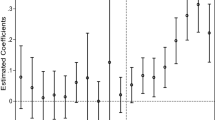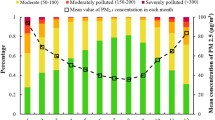Abstract
Tourism is regarded as a major global industry. Given the importance of identifying factors affecting the tourism industry and attracting international tourists, the present ecological study explored the impact of environmental pollution on the number of international tourists arrival using concentrations of PM2.5 (particulate matter 2.5 μm or less in size) in a multivariate framework under the context of 190 countries. Using panel data from 190 countries, the author explored the data on the number of international tourists arriving in countries in 2017 extracted from the World Bank (WB) website, and obtained the information about the concentrations of PM2.5 from the World Health Organization (WHO) website. Pearson’s correlation coefficient and linear regression analysis were used to examine the correlation of the number of tourists with the variables of daily concentrations of PM2.5, societal safety, international conflict, and the relationship of tourist arrival with the studied variables, respectively. The number of countries with low, moderate, and high concentrations of PM2.5 in urban areas was 33, 116, and 41, respectively. This numbers for rural areas was 47, 102, and 42 countries, respectively. The mean concentrations of PM2.5 in the surveyed countries was 23.90 ± 15.81 and 25.69 ± 16.76 for rural and urban areas, respectively. The estimation results revealed that there was a significant correlation between the number of tourists with the concentrations of PM2.5 in the rural areas (p = 0.01). There was also a significant relationship between the human development index (HDI) and the concentration of PM2.5. A significant relationship was observed in the results of univariate linear regression analysis between tourist arrival with rural concentrations of PM2.5 (p = 0.02) and societal safety (p = 0.003). After adjusting the effect of societal safety variables, domestic and international conflict, the relationship between tourist arrivals and concentrations of PM2.5 in rural area remained significant (p = 0.02). The results imply that by reducing the concentration of PM2.5 the positive attitude of tourists for traveling to countries with healthy air can be earned.



Similar content being viewed by others
References
Musai M. A study of demand factors on foreign tourism in Iran. IAU Int J Soc Sci. 2013;3(4):35–42.
Rafsanjani S, Zamanian G. Factors affecting tourism demands in selected OIC countries. Environ Energy Econ Res. 2018;2(4):229–36.
World Tourism Organization. World tourism barometer - Nov 2019 [cited February 10, 2020]. Available from: https://www.unwto.org/world-tourism-barometer-2019-nov.
Balaguer J, Cantavella-Jorda M. Tourism as a long-run economic growth factor: the Spanish case. Appl Econ. 2002;34(7):877–84.
Fayissa B, Nsiah C, Tadasse B. Impact of tourism on economic growth and development in Africa. Tour Econ. 2008;14(4):807–18.
Akan Y, Arslan I, Isik C. The impact of tourism on economic growth: the case of Turkey. J Tour. 2007;9(1):1–24.
Rokni L, Park SH. Medical tourism in Iran, reevaluation on the new trends: a narrative review. Iran J Public Health. 2019;48(7):1191–202.
Hanefeld J, Horsfall D, Lunt N, Smith R. Medical tourism: a cost or benefit to the NHS? PLoS One. 2013;8(10):e70406.
Davison SP, Hayes KD, LaBove G, Shaffer P. The Price of medical tourism: the legal implications of surgery abroad. Plast Reconstr Surg. 2018;142(4):1075–80.
Sajjad F, Noreen U, Zaman K. Climate change and air pollution jointly creating nightmare for tourism industry. Environ Sci Pollut Res Int. 2014;21(21):12403–18.
Dong D, Xu X, Wong YF. Estimating the impact of air pollution on inbound tourism in China: an analysis based on regression discontinuity design. Sustainability. 2019;11(6):1–18.
Zhang K, Hou Y, Li G, Huang Y. Tourists and Air Pollution: How and Why Air Pollution Magnifies Tourists’ Suspicion of Service Providers. J Travel Res. 0047287519859710.
Wang L, Fang B, Law R. Effect of air quality in the place of origin on outbound tourism demand: disposable income as a moderator. Tour Manag. 2018;68:152–61.
Numbeo. Pollution Index 2019 2019 [cited February 10, 2020]. Available from: https://www.numbeo.com/pollution/rankings.jsp.
WHO. 9 out of 10 People Worldwide Breathe Polluted Air, but More Countries Are Taking Action 2018 [cited February 15, 2020]. Available from: http://www.who.int/ news-room/detail/02-05-2018-9-out-of-10-people-worldwidebreathe- polluted-air-but-more-countries-are-taking-action.
Becken S, Jin X, Zhang C, Gao J. Urban air pollution in China: destination image and risk perceptions. J Sustain Tour. 2017;25:130–47.
Peng J, Xiao H. How does smog influence domestic tourism in China? A case study of Beijing. Asia Pac J Tour Res. 2018;23:1115–28.
Deng T, Li X, Ma M. Evaluating impact of air pollution on China’s inbound tourism industry: a spatial econometric approach. Asia Pac J Tour Res. 2017;22:771–80.
Aratuo DN, Etienne XL. Industry level analysis of tourism-economic growth in the United States. Tour Manag. 2019;70:333–40.
Frossard MS, Fraga C. Tourism, railway and advertising: the construction of feelings and meanings in the posters of railroads in the United Kingdom (1890–1970). Anais Brasileiros De Estudos Turisticos-AbeT. 2018;8:43–55.
Mondal M, Dandapath PK. Urbanization and its impact on coastal eco-tourism in West Bengal. Int J Sci Res. 2013;2:114–9.
WHO. Ambient (outdoor) air pollution, Particulate matter (PM) Definition and principal sources 2018 [cited January 25, 2020]. Available from: https://www.who.int/news-room/fact-sheets/detail/ambient-(outdoor)-air-quality-and-health.
WHO. WHO Air quality guidelines for particulate matter, ozone, nitrogen dioxide and sulfur dioxide 2005 [cited February 20, 2020]. Available from: https://apps.who.int/iris/bitstream/handle/10665/69477/WHO_SDE_PHE_OEH_06.02_eng.pdf;jsessionid=615DF1E2C5EF7B6BE2DD7A2E37D1B355?sequence=1.
World Heal Organization. Global Health Observatory data repository, Ambient air pollution, Exposure Country average 2016 [cited 2020 February 04, 2020]. Available from: http://apps.who.int/gho/data/node.main.152?lang=en.
The World Bank. International tourism, number of arrivals 2017 [cited February 01, 2020]. Available from: https://data.worldbank.org/indicator/ST.INT.ARVL.
Institute for Economics and Peace. Global Peace Index 2017 [cited 2020 January 26, 2020]. Available from: http://visionofhumanity.org/app/uploads/2017/06/GPI-2017-Report-1.pdf.
United Nations Development Programme. Human development report 2017[cited February 11, 2020]. Available from: http://hdr.undp.org/en/data
Naddafi K, Hassanvand MS, Faridi S. Review of studies on air quality status and its health effects in Iran. Iran J Health Environ. 2019;12(1):151–72.
Jaafari J, Naddafi K, Yunesian M, Nabizadeh R, Hassanvand MS, Ghozikali MG, et al. Study of PM10, PM2.5 and PM1 levels in during duststorms and local air pollution events in urban and rural sites in Tehran. Hum Ecol RiskAssess: Int J. 2017;24:2. https://doi.org/10.1080/10807039.2017.1389608.
Santra S. Is human development index (HDI) a reflector of quality of air? A comparative study on developed and developing countries. Int J Sci Res Publ. 2014;4:1–6.
Bruce N, Perez-Padilla R, Albalak R. Indoor air pollution in developing countries: a major environmental and public health challenge. Bull World Health Organ. 2000;78:1078–92.
Majra J. Air quality in rural areas. Chemistry, Emission Control, Radioactive Pollution and Indoor Air Quality: IntechOpen; 2011.
Xu X, Reed M. Perceived pollution and inbound tourism for Shanghai: a panel VAR approach. Curr Issue Tour. 2019;22:601–14.
Anaman KA, Looi CN. Economic impact of haze-related air pollution on the tourism industry in Brunei Darussalam. Econ Anal Policy. 2000;30:133–43.
Law R, Cheung C. Air quality in Hong Kong: a study of the perception of international visitors. J Sustain Tour. 2007;15:390–401.
Xu X, Dong D, Wang Y, Wang S. The Impacts of Different Air Pollutants on Domestic and Inbound Tourism in China. Int J Environ Res Public Health. 2019;16:5127.
Wang L-J, Chen M-H. Nonlinear impact of air quality on tourist arrivals: new proposal and evidence. J Travel Res. 2020;0047287519899993.
Gani A, Clemes MD. The main determinants effecting international visitor arrivals in New Zealand: some empirical evidence. Tour Econ. 2017;23(5):921–40.
Law R, Cheung C. Air quality in Hong Kong: a study of the perception of international visitors. J Sustain Tour. 2007;15(4):390–401.
Michalko G. Tourism eclipsed by crime: the vulnerability of foreign tourists in Hungary. J Travel Tour Mark. 2004;15(2–3):159–72.
Shin Y-S. Safety, security and peace tourism: the case of the DMZ area. Asia Pac J Tour Res. 2005;10(4):411–26.
Pratt S, Liu A. Does tourism really lead to peace? A global view. Int J Tour Res. 2016;18(1):82–90.
Harb A. Impact of War And Terrorism on Tourism and Hospitality Sector in Lebanon. Annual of Sofia University" St. Kliment Ohridski. 2016;109(2).
Bandara JS. The impact of the civil war on tourism and the regional economy. South Asia: J South Asian Stud. 1997;20(s1):269–79.
Asongu SA, Nnanna J, Biekpe N, Acha-Anyi PN. Contemporary drivers of global tourism: evidence from terrorism and peace factors. J Travel Tour Mark. 2019;36(3):345–57.
Author information
Authors and Affiliations
Corresponding author
Ethics declarations
Conflict of interests
The authors of this article declare that they have no conflict of interests.
Additional information
Publisher’s note
Springer Nature remains neutral with regard to jurisdictional claims in published maps and institutional affiliations.
Rights and permissions
About this article
Cite this article
Hemmati, F., Dabbaghi, F. & Mahmoudi, G. Relationship between international tourism and concentrations of PM 2.5: an ecological study based on WHO data. J Environ Health Sci Engineer 18, 1029–1035 (2020). https://doi.org/10.1007/s40201-020-00524-6
Received:
Accepted:
Published:
Issue Date:
DOI: https://doi.org/10.1007/s40201-020-00524-6




